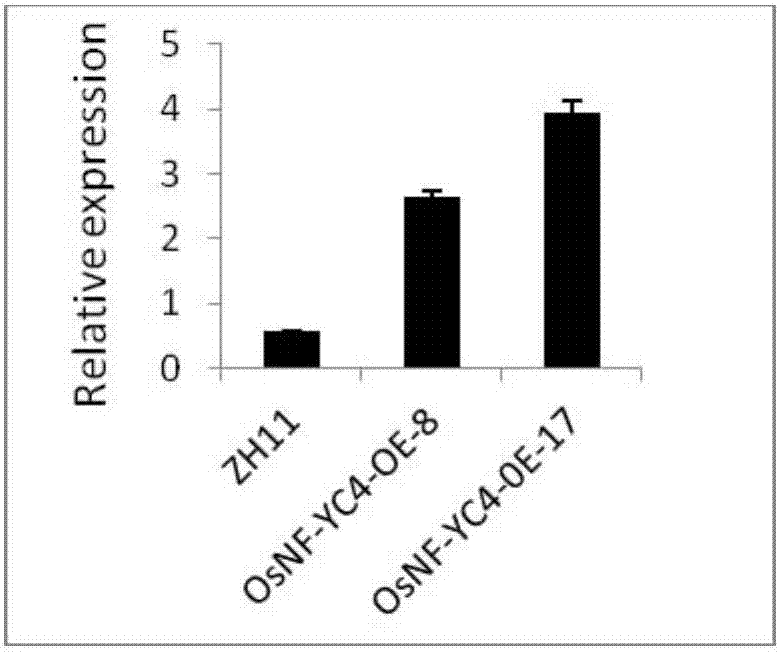Rice gene OsNF-YC4 and applications thereof
A gene and rice technology, applied in the rice gene OsNF-YC4 and its application fields, can solve the problems of complex regulation mode, complex physiological and biochemical changes, limited functional genes, etc., and achieve wide application prospects, widened grain width, and grain length lengthening effect
- Summary
- Abstract
- Description
- Claims
- Application Information
AI Technical Summary
Problems solved by technology
Method used
Image
Examples
Embodiment 1
[0025] Example 1 The cDNA cloning and identification of rice OsNF-YC4 and its coding gene
[0026] The experimental materials were provided by the Research Office of Plant Hormone Regulation Group, South China Botanical Garden, Chinese Academy of Sciences, and the materials were planted in the greenhouse and managed in the conventional field.
[0027] The method of bioinformatics was used to analyze, design primers, and clone the rice gene OsNF-YC4. The specific method is as follows:
[0028] OsNF-YC4 gene ORF forward primer P1 is shown in SEQ ID NO.3.
[0029] OsNF-YC4 gene ORF reverse primer P2 is shown in SEQ ID NO.4.
[0030] Two-week-old young leaves of rice materials were taken, ground in liquid nitrogen, and RNA extraction was carried out according to TIANGEN total RNA extraction kit RNA Plant Extraction kit DP417. cDNA first-strand synthesis was based on TaKaRa reagent company cDNA first-strand synthesis kit TaKaR a PrimeScript TM 1st strand cDNA Synthesis Kit D61...
Embodiment 2
[0032] Utilize the Nde1 and EcR1 endonucleases of Takara Company and the T4-DNA ligase of Takara Company to positively insert the cloned gene OsNF-YC4 of Example 1 into the expression vector Pubi vector, transform E. Positive clones were screened on LB solid medium with L kanamycin. After sequencing verification, the plasmid was extracted to obtain the plant excess Pubi-OsNF-YC4 expression vector ( figure 1 ). Pubi-OsNF-YC4 was transformed into Agrobacterium tumefaciens strain EHA105 (Biovector Co., LTD) by freeze-thaw method. The wild-type rice ZH11 was respectively transformed by Agrobacterium EHA105. Extract the genomic DNA of transgenic rice as a template, use the wild-type rice genome and water as a negative control, and the Pubi-OsNF-YC4 plasmid as a positive control, and use the internal primers of the target gene to perform PCR to initially identify positive transgenic rice. The method is as follows:
[0033] Design internal primers P3: SEQ ID NO.5 and P4: SEQ ID NO...
Embodiment 3
[0036] Example 3 Functional verification of OsNF-YC4 gene
[0037] Disinfect the transgenic rice seeds of the T1 generation and sow them in tissue culture bottles. The culture temperature is 28°C, and the day and night time is 12 / 12h. After the rice grows for 3 weeks, the wild-type ZH11 and overexpressed rice are treated with 40°C high temperature and 10% PEG to simulate drought. Strains OsNF-YC4-OE-8, OsNF-YC4-OE-17, after 10 days, it can be clearly observed that the leaves of overexpressed rice seedlings remain bright green, and the leaves of wild-type seedlings die, such as Figure 4 .
[0038] Further grain statistics of the overexpressed rice lines grown in the greenhouse showed that compared with wild-type ZH11, the rice grain width of the overexpressed lines OsNF-YC4-OE-8 and OsNF-YC4-OE-17 was significantly wider, In addition, the thousand-grain weight of the two overexpression lines reached a very significant level compared with the wild type ZH11, and the stem lengt...
PUM
 Login to View More
Login to View More Abstract
Description
Claims
Application Information
 Login to View More
Login to View More - Generate Ideas
- Intellectual Property
- Life Sciences
- Materials
- Tech Scout
- Unparalleled Data Quality
- Higher Quality Content
- 60% Fewer Hallucinations
Browse by: Latest US Patents, China's latest patents, Technical Efficacy Thesaurus, Application Domain, Technology Topic, Popular Technical Reports.
© 2025 PatSnap. All rights reserved.Legal|Privacy policy|Modern Slavery Act Transparency Statement|Sitemap|About US| Contact US: help@patsnap.com



